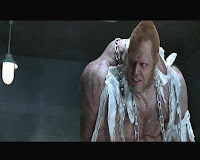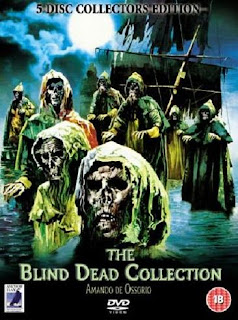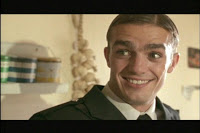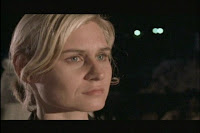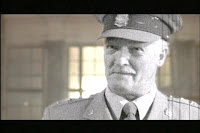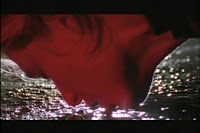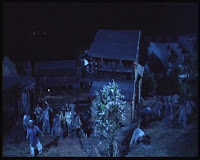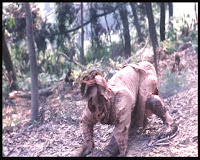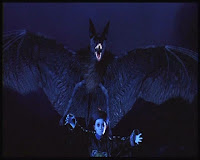The Blind Dead series consisted of four films from director Amando de Ossorio, these being “Tombs of the Blind Dead” (1971), “Return of the Evil Dead” (1973), “The Ghost Galleon” (1974) and “Night of the Seagulls” (1975). All four films are collected in an Anchor Bay 5 disc Box-set, all have been restored.
The series was brought to my attention by
Leila who told me that, firstly, these were (in the main) great Euro-Horror – enough to make me want to see them - and that also, some of the films could be classed as vampire. In truth Amando de Ossorio does change his premise and mythology, as well as the series’ direction, in each film and thus I intend to look at each film individually in a mass, and therefore unapologetically long, Vamp or Not?
Tombs of the Blind Dead.
First of the series, in which we are introduced to the Blind Dead. The film starts with views of the abandoned village of Berzano, a skeletal hand inching out of a crypt and a woman screaming. This opening is throwaway, but worth noting that it is daylight and not as pathetic as the alternative opening (on the DVD extras) that tried to tie the film in with Planet of the Apes, in a shameless marketing ploy!
At some seaside resort, old school friends Virginia (María Elena Arpón) and Bet (Lone Fleming) bump into each other. They’re pleased to see each other and yet there is a sense of some form of upset in their past. Virginia’s friend Roger (César Burner) turns up and invites Bet to a weekend in the country that they are arranging. Off they go, on a steam train, and we get more of a sense of issues – though it, at first, seems like Virginia is jealous of the attention Roger gives Bet.
We then discover that, in school, Bet and Virginia had a lesbian affair and the issue seems to be more one of embarrassment on Virginia’s part. Discovering that there is no stop before their destination, Virginia gathers her bag and jumps off the moving train. This is noticed by Bet and Roger and they pull the alarm cord – the train driver refuses to stop.

Virginia reaches the ruins of Berzano and decides to camp down for the night. In the ruins we have seen graves with ankhs rather than crosses – and I’ll return to the specific design of those later. Anyway, we begin to see mist or smoke rising from the graves and then the blind dead awaken. On first view they look very much like desiccated zombies but let’s take a closer look at them.
They do move very slowly, a zombie attribute, however they seem to be a little more sentient than your typical zombie. At one point one reaches through a break in a door to lift the bar that is locking it, this shows an awareness that you wouldn’t often see in a zombie – late on in the film we see one use a sword – again tool use is not a common zombie attribute.

In this first encounter however we see something that is most definitely out with the zombie genre – they ride horses. Indeed, though we are never sure where these horses materialise from, they end up chasing Virginia down when she steals a horse. Of course she is caught. Just a note about the horseback scenes, filmed in slow motion with a kind of electronic echo to the sound of the hooves these are hauntingly atmospheric scenes.
The next day the two friends go looking for her on horses they hired from their hotel and seem to get stuck in the abandoned village when their horses bolt. Comment is made by them that the ankh’s in the graveyard are satanic in nature,

which irked me but is corrected later. However, they are found by the police, who have Virginia’s body. Her body is covered in bite marks but they are not enough to have killed her. She has died through loss of blood and this is a clear vampiric indication. These dead are not flesh-eaters but blood drinkers and if you look at the screenshot the bites do not look like the typical zombie attack bite marks shown in cinema as they are not deep at all.

The fact that Virginia rises as one of the dead could come from either the zombie or vampire myth. However, when she does rise and attacks the very creepy morgue attendant (Simón Arriaga) she goes for the neck and is clearly drinking blood rather than eating flesh.
For now I’ll jump the next part of the film, which explains how the blind dead were created, and follow what happens with Virginia. Rather than heading out and attacking the first warm-blooded human she sees, she heads for Bet’s

mannequin factory. This shows a purposefulness that is not often associated with zombies. Bet is not there but her assistant Nina (Verónica Llimera) is. Nina manages to set Virginia alight. Fire is not a common zombie killing tool, and certainly we would expect a zombie to lumber on and not scream in the flames as Virginia does and fire, of course, is often used against vampires. It should be noted that Virginia is the only victim we see rise.
Jumping back, Roger and Bet go to see a Professor Candal (Francisco Sanz) an expert on the Templars. We discover that these Templars returned from the Holy Land obsessed by the occult and having adopted the symbol of the Pharaohs (the ankh) as the symbol of everlasting life. They conducted the Tenebrae Ritual, which in itself is an interesting name.
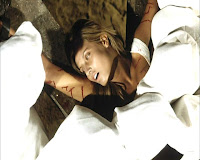
Tenebrae is Latin for darkness and is most commonly associated with religious services conducted by Christian churches to commemorate Christ’s death over the Easter period that are performed at night. Whether this was used in the film as a corruption of the Christian rituals or simply because of the Latin translation I do not know. We see the ritual and a virgin girl is cut many times by knights on horseback and then the knights feed from her blood – using virgin blood to gain life after death is rather vampiric.
The Knights were tried for their crimes and hung, their eyes pecked out by crows – hence them being blind and forcing them to hunt by sound. There is a marvelous scene as Bet watches (Candal's son) Pedro’s girl being devoured, trying to remain silent and yet she can hear her own heartbeat, so can the Blind Dead. Hearing the heartbeat of a victim is often used in vampire films and, whilst the inclusion here is less to do with a vampiric nature and more to do with them being blind and, perhaps, our own centre of life (the heart) betraying us to the dead, it is worthy of noting in a genre sense.
The other aspects to look at are the fact that whilst sunlight seems to be ineffective (it appears that Virginia is on the prowl during the day, and the opening scene is in daylight)

the blind dead by rote rise at night (to the ringing of the abbey bell) and then return to their graves – certainly a trait more vampiric than zombie, indeed in traditional vampire myth a need for the dead to return to their graves during the day was a sure sign of vampirism. It is also clear that the blood they drink sustains their life, but does not heal them or offer youth - Virginia, once dead, maintains her wounds, the blind dead have no eyes and have become desiccated husks.
Just to note that the ending is really quite downbeat – it is a fantastic ending to a marvelous piece of Euro-horror. Okay, the effects are a bit hokey, but that is part of the joy.
So a real crossover film, and not a standard vampire flick, but there is enough in this to push me towards believing this movie should have a place in vampire filmographies.
The imdb page for Tombs of the Blind Dead is
here.
Return of the Evil Dead
As I said in my introduction, the mythology and direction of these films changed from movie to movie. This is less a sequel than it is a re-imagining, and begins in the 14th Century in
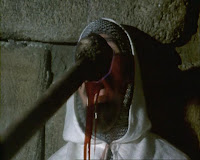
the village of Bouzano (note the spelling has changed) in Portugal on the Spanish border. What we see here is the death of the Templars, however this time they are not arrested but taken by the village folk. To prevent them from returning and hunting them the villagers burn out their eyes (as opposed to crows pecking them out) and then they are burnt to death (rather than being hung). As they die they swear revenge.
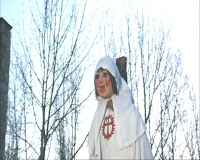
Modern day Bouzano and the village is to celebrate the burning festival (remember in the first film the whole region was uninhabited, the village abandoned). Guys are being built to be burnt, and if you look at the screenshot you’ll see that they are not only in Templar robes but they sport rather wicked looking fangs. We see a gang of kids attack misshapen hunchback Murdo (José Canalejas). He is saved by a young woman called Moncha (Loli Tovar).
Jack Marlowe (Tony Kendall) has come to the village as he is a firework specialist and meets with Mayor Duncan (Fernandon Sancho), the mayor’s fiancée Vivian (Esperanza Roy) and the mayor’s right hand man Da Costa (Frank Braña). Vivian takes Jack to the ruined abbey and it becomes readily apparent that they have history.
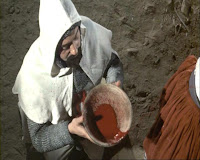
At the ruins they meet Murdo and he tells them that the dead are unhappy and explains the ritual that the Templars used to cheat death. We see the ritual again, but it has changed from the first film. The title Tenebrae is not used and there is no cutting with swords from horseback, this time the sacrifice is stabbed by dagger, her blood gathered in a bowl and drank by the knights whilst their leader eats the heart.
Murdo obviously has a grudge, in respect to the way he has been treated, as he has kidnapped a girl and sacrifices her, that night, in the graveyard. As her blood spills upon the soil, the ground smokes and the dead rise. It is clear, therefore, that these dead have been dormant since their deaths and it is blood which revives them. This is, of course, rather vampiric. Again horses appear from nowhere.
The first to be attacked are Moncha and her lover. This provides one interesting insight - the Templars hammer at the door for entry with the hilt of a sword. Rather like Virginia, in the first movie, Moncha tries to get away by stealing a Templar horse. Unlike Virginia she does get away and we discover, in the process, a little about the horses. We still do not know where they have come from but we now know that they, like the Templars, are dead.
The Templars attack the village and seem intent neither on flesh eating nor blood drinking. In this case they are interested only in slaughter, mainly with sword, their motivation is revenge. This is really not very zombie like and much more the sort of behaviour we’d expect from more sentient undead. We discover, via the film, that fireworks (used like a bomb) and fire are effective against them. Given their mortal deaths, fear of fire seems logical. None of those slaughtered appear to rise again.
The majority of the film is a siege with a handful of survivors in a church. The use of the church does not seem to have a religious basis, after all the Templars are trying to get in, but more down to a big solid door to hide behind. The real danger in the film is human greed and hatred. It is at the end of the film that things get interesting. We have three survivors, Jack, Vivian and a small child. They decide to sneak away and blindfold the child to keep her quiet (on the basis that if she can’t see she won’t scream). They are edging past the blind dead when the child takes off her blindfold and screams.

The dead don’t react. Jack touches one and it falls and then they all fall. They have died with the sunrise. This is very vampiric and whilst they do not crumble to dust, given that they are fairly desiccated already, nor burst into flame I believe this gives us a rather large tell. The unfortunate aspect of the ending is that it is, almost, a happy ending – unlike in the first film which was wonderfully disturbing.
I’ll mention that the child refers to the Templars as skeletons, whilst they are certainly skeletal in appearance a better description appears in the next film. The Templars also seem, if anything, more intelligent than in the previous film. At one point they trap a child against a doorway, by fastening her coat with a dagger, rather than just killing her, so that she becomes bait for the adult survivors.
So, in film number two we have immortality via a blood ritual, rebirth through a blood ritual, a desire for revenge, a fear of flame, cognisant thought, death in the sun and the villager’s be-fanged representations. Whilst the siege aspect was reminiscent of “Night of the Living Dead”, I believe this film also deserves a place in vampire filmographies. Like the first this is also a great piece of Euro-horror and is definitely worth a watch despite, again, some hokey effects and, in this film, some very orange blood.
The imdb page for Return of the Evil Dead is
here.
The Ghost Galleon
This is a very weak entry in the series, to my way of thinking the weakest actually, and yet it has a certain something. Once more Amando de Ossorio changes the rules, although it is difficult to tell if he has changed the basic mythology again as we get very little in the way of background in this movie. What made this more difficult to watch was the terrible dubbing. Giving the first two movies were in original language and then subtitled one wonders why Anchor Bay couldn’t do the same with this one.
Over the credits we see a horned skull with glowing eyes; this is actually plot necessary and not just for show. After the credits we meet Noemi (Bárbara Rey) who works for model agency owner Lillian (Maria Perschy). Her roommate and lover Kathy (Blanca Estrada) is missing. She demands to know from Lillian where Kathy is but Lillian pleads ignorance - that is until Noemi threatens to go to the police. She is told to meet Lillian at the docks and it is revealed that Kathy, and another model Lorena (Margarita Merino) are out at sea for a publicity stunt for client Howard Tucker (Jack Taylor).
They make radio contact with the girls and they say a fog is descending. A galleon comes out of the fog and, ignorant of the warning flares the girls put up, hits their boat. Their boat is taking on a little water and they ask for rescue. Noemi is incensed so Tucker has his right hand man Sergio (Manuel de Blas) tie her up until the girl’s are rescued – so that she does not spoil the stunt.

Lorena decides to board the ship and Kathy falls into a sleep that seems unnatural, not even waking fully when Lorena screams. Later Kathy does go aboard, falls asleep in a cabin and is then got by the blind dead – who seem to spend most of their time in crates. Meanwhile the others can’t find the girls by helicopter and so go to see Professor Grüber (Carlos Lemos) at the metrological station. He says that fog never forms in the area of sea they are looking at. He is dismissive until they mention the galleon, a ship that the Professor has heard appears and whichever boat sees it vanishes. Tucker is going out to sea to find them and Grüber insists on coming too. So we end up with the Professor, Tucker, Sergio, Lillian and (forced to come along) Noemi on Tucker’s yacht. A mist falls and they see the galleon, though the girls’ boat has now vanished.
They board the galleon but it seems deserted. Grüber insists that the boat is not actually real, neither is the mist, that they have strayed into another dimension – bear with me, we get more on this later. The galleon, from a distance, looks pretty darn rubbish as it is clearly a model but on board, where the mist puts everything into a perpetual

night, it is pretty darn atmospheric. They look down to their launch and it vanishes – returned to their dimension says Grüber – they end up bunking down for the night. As the others sleep Noemi explores, looking for Kathy. She is banging away in the hold when the blind dead emerge from their crates and attack. They injure her throat but she manages to crawl up to deck before being grabbed and taken down into the hold.

Once in the hold we finally see their feeding (up to now we only heard Lorena scream and saw Kathy carried off). In the first film they were blood drinkers, in film two they simply killed but in this they decapitate the victim and then eat the flesh. The eating of flesh is particularly zombie (though not unknown in the vampire genre) but a zombie wouldn’t normally decapitate (with a sword) the victim first. This method of feeding really is an oddity.
The next day Grüber finds a ship’s log and things get clarified (at least a little) this 16th century galleon was carrying the sarcophagus/crates of the Templars – plus treasure (don’t they always). There is no mention of any blood ritual, just that the Templars had been excommunicated by the pope. They are described as mummified corpses, a much better description than that of skeletal (from film 2) as they still have a leathery skin. The Professor also points out a certain smell in the air like a chemical some plants give out that causes a narcotic effect – hence them sleeping so much and much too damn convenient to my way of thinking.

Exploring the ship further they discover the treasure and Sergio is gathering as much as he can when the dead awaken. The four manage to get to deck but the dead are coming for them. Suddenly Grüber remembers that he knows exorcism (!) and Cushings a cross together (ie ties two bits of wood together). Unusually he pours petrol from a lighter over the binding and sets the cross alight. Using this he forces the dead back into the hold.
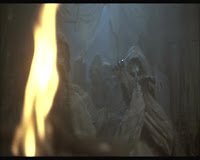
Now, to be honest, we never do know whether it was the cross itself, Grüber’s rather unimpressive words of exorcism or the fire which pushes them back. All we do know is that it is successful and that, in the second film, they are afraid of fire – though given that the rules change from film to film this means little. If we could be certain that it is the cross then the reaction would be vampiric but we cannot really tell.
Stuck on the boat (a passing ocean liner does not see them as it is in our dimension) they decide to go on the offensive and throw the dead’s crates overboard. This causes the galleon to pass back into our dimension as the ghouls (as the dialogue describes them) are gone. They decide to swim to shore, leaving Grüber to be rescued later as he can’t swim. The three in the water are using a plank as a raft but it cannot support their weight and the weight of the treasure carried by Sergio. He tries to kill Tucker, to lower the weight, and is stabbed by Lillian for his trouble.
On board ship, the skull (from the credits) that was in the treasure room suddenly gains glowing

eyes and the galleon bursts into flames, the smoke suffocating the Professor. Lillian and Tucker get back to dry land and collapse on the beach. Suddenly out of the water the dead begin to surface. Now we should note that it is daytime and so the dying in sunlight rule has vanished somewhere. The final shot of the film is a point of view shot of the two survivors as the dead descend on them.
It is a great ending, returning to ending on a note of doom, to what is truthfully a weak film – strong in atmosphere I’ll grant you – but the story sucks. It is as if it was suggested that a new blind dead movie be made and, well wouldn’t it be cool if they were on a galleon? How do we get them there? We’ll make something up. The only real evidence for ‘Vamp or Not?’ we have (taking from this film only) is perhaps they were scared by the cross and, more on the zombie side, flesh-eating. I’d have to fall on not vampire for this movie.
The imdb page for The Ghost Galleon is
here.
Night of the Seagulls
The most intriguing film title of the series, certainly, this was actually one of my favourites (if not my favourite). That said I could understand if fans of the earlier films were turned off by this, it is so unlike those which went before. Think Lovecraft, think essence of Dagon and Shadow over Innsmouth and you are about on the right track. This, like the last film, was dubbed but the dubbing was much less intrusive.
The film starts in the middle ages and a couple travelling to their new home are lost. The man leaves his wife at the cart whilst he goes to a house to ask for help. We see the (living) Templars riding along. They reach the man, who has been unable to gain entry to the house and they stab him. Then they nick off with his wife; serves her right for wearing an outfit that, forget not containing her cleavage, fails to contain her nipples!
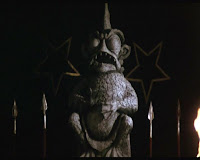
She is taken to their castle and tied before the foot of a statue that has all the hallmarks of Lovecraft. She is sacrificed and her heart is placed in the mouth of the statue. We then see the Templars descend upon her, presumably to drink her blood, though that is not clear. Crabs then eat her dismembered body. I said it is not clear if they drank her blood but what is clear is that they do not do anything similar to their sacrifices once they, themselves, are dead. I say that not only because we do not see it but because when we see the crabs take a sacrifice later, she is not dismembered. This is the only background we get to the Templars in this film, except for a comment that they originally came from France.
Cut to the present day (or it was when this was shot, the clothing however never survived the seventies!) Doctor Henry Stein (Víctor Petit) and his wife Joan (María Kosti) are taking over a rural practice. The town seems very unfriendly, not liking outsiders and the retiring Doctor (Javier de Rivera) only advices them to leave and, if they don’t, not to pry and not to go out at night. Of course they do pry and they do go out at night. Eventually they befriend a mentally handicapped young man called Teddy (José Antonio Calvo) who is regularly beaten by the locals and orphan young lady Lucy (Sandra Mozarowsky), both are clearly scared.

The story, as it unfolds, is that the Templars continue with their sacrifices and the villagers are complicit. Every year the Templars rise from their graves and, on seven consecutive nights, seven maidens are selected by the villagers to be sacrificed. They do this as to not comply would see them all slaughtered by the Templars. Of course the Doctor gets involved, Lucy is selected and he interferes leading to the wrath of the Templars descending upon them. This is a brief précis that does not do the film justice, but there is little to help the ‘Vamp or Not?’ until the ending and the précis is short but accurate, the true strength of the film is in the amount of atmosphere and paranoia it manages to produce and that must be seen to be appreciated.
I will add that, after our last adventure out at sea, this film sees the return of the Templars’ dead horses. Once again some of the horses are stolen by mortals in order to get away from the dead. This time, however, the Templars seem to have the horses well trained and they take the horse thieves to where they want – i.e. the Templars’ castle.

During the film Henry manages to kill a Templar by setting it on fire. However, this is not new in the series and, if anything, these blind dead seem less bothered by flames than they did in previous films. Moving on, the film ends with Henry and Joan trapped in the Templars’ castle, with dead rising from sarcophagi. Henry has realised that they have selected Joan to be the next sacrifice. The idol stands above them and they, after putting much effort in, smash it.

The results are spectacular. The dead collapse all at once, dying. The factor that makes this spectacular is the profusion of gushing blood that floods from the eye-sockets as they die. There doesn’t seem to be a logical reason for this, over than the fact that it looks pretty darn cool. However, we can tell from this that it was the idol, which the Templars worshipped, that gave them life beyond death, and whilst a physical idol that bestows undeath is not unheard of in vampire movies it is not common, nor is it a strong indicator to a movie being genre.
With this one, like the last, I’m leaning towards not vampire. Yet it is a fantastically moody film, brimming with atmosphere, that both fans of 70s Euro-horror generally and those who love Lovecraftian fare should really want to experience. Incidentally, I mentioned the film’s title being intriguing, it comes from the fact that when the Templars ride, though it is night, seagulls cry and those birds are said to be the anguished souls of the maidens who have been sacrificed.
The imdb page for Night of the Seagulls is
here.
Additional thoughts on the series
I have examined each film, looking for vampiric elements and yet, as a series, I have to say this is worth the time of any aficionado of 70s horror, not just those seeking vampiric or zombie goodness. Even the weakest of the films, the Ghost Galleon, is so much stronger than Ossorio’s earlier and, quite frankly, rubbish
Fangs of the Living Dead.
If I had one main issue with the series it is that Amando de Ossorio seemed obsessed, at least through the first three films, with putting a rape/attempted rape scene in the film. In the first film Pedro rapes Bet, in the next Da Costa attempts to rape Vivian and in the third it is intimated that Sergio raped Noemi. I didn’t mention this in the main body because the events added nothing to what I was looking at (i.e. was it a vampire orientated film). My objection to these scenes was not born of a prudish nature but because they were gratuitous and, over three films, became somewhat of a pattern. Perhaps Ossori wanted to show just how despicable humanity is, and therefore we deserve the fate dealt to us by the blind dead, I don’t know.
That said, despite the last paragraph, these films brim with atmosphere and as all four are available in one set I’d encourage all horror fans generally to give them a go.






